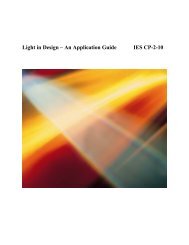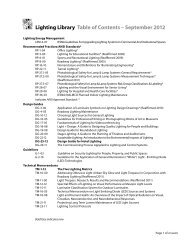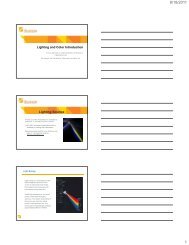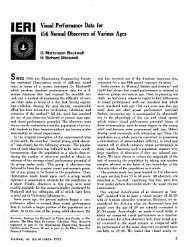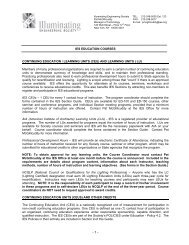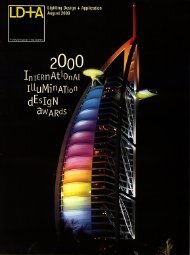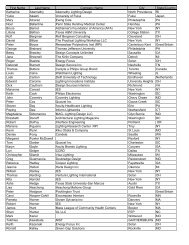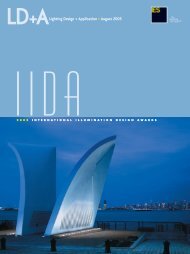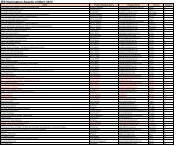light products - Illuminating Engineering Society
light products - Illuminating Engineering Society
light products - Illuminating Engineering Society
You also want an ePaper? Increase the reach of your titles
YUMPU automatically turns print PDFs into web optimized ePapers that Google loves.
What is Life Cycle Assessment<br />
LCA is a systematic process of analyzing the environmental impacts of a<br />
product, system or service, throughout the product life cycle from “cradle<br />
to grave” or “cradle-to-cradle.” This analysis includes the different<br />
phases of resources extraction, manufacture, distribution, installation, use<br />
and disposal. ISO and the <strong>Society</strong> of Environmental Toxicology and<br />
Chemistry (SETAC), among others, have developed standards for conducting<br />
LCA.<br />
Unlike single attribute metrics such as recycled content, the output of<br />
LCA provides quantitative data on fundamental impact categories such<br />
as global warming or ecological toxicity.At present there is not consensus<br />
on a complete list of all impact categories, but the most often recognized<br />
impact categories are listed below as defined by the U.S.<br />
Environmental Performance Agency’s program called TRACI for Tool for<br />
the Reduction and Assessment of Chemical and Other Environmental<br />
Impacts, see http://www.epa.gov/ORD/NRMRL/std/sab/traci/<br />
Impact Category<br />
Global Warming Potential<br />
Acidification<br />
Eutrophication<br />
Ozone Depletion<br />
Smog<br />
Ecotoxicity<br />
Human Health<br />
Fossil Fuel<br />
Land Use<br />
Water Use<br />
Criteria Air Pollutants<br />
Possible End Points<br />
Malaria, coastal area damage,<br />
agricultural, forest damage<br />
Plant, animal, ecosystem<br />
Plant, animal, ecosystem<br />
Skin cancer cataracts, material<br />
damage, crop damage<br />
Human mortality, asthma, plant<br />
damage<br />
Plant, animal, ecosystem<br />
Variety of specific human cancers<br />
Fossil fuels shortages leading to<br />
use of other energy sources<br />
Threatened and<br />
endangered species<br />
Water shortages<br />
Disability-adjusted life years,<br />
toxicological human health effects<br />
Each impact category is characterized by an equivalent emission of a<br />
causal substance. For instance, since CO 2 emissions are the largest cause<br />
of global warming, Global Warming Potential (GWP), is measured in<br />
equivalent emissions of CO 2 with emissions other than CO 2 effecting<br />
global warming being converted to an equivalent effect of emitted CO 2 .<br />
First note that impact categories<br />
listed in the first column are defined<br />
in terms of fundamental attributes,<br />
such as Global Warming Potential<br />
(GWP) and Ozone Depletion<br />
Potential (ODP), as opposed to secondary<br />
variables like recycled content<br />
or even energy efficiency. In other<br />
words, we intuitively accept that<br />
lower energy consumption correlates<br />
to “better” environmental performance,<br />
but in fact it is reductions in<br />
power plant emissions contributing<br />
to global warming and acidification,<br />
among others, that are the actual<br />
benefits to the environment.<br />
Also note that the units for each<br />
impact category are listed in the second<br />
column and are different for each<br />
impact category. For instance GWP is<br />
measured in kg of CO 2 whereas ODP<br />
is measured in kg of CFC-11. As a<br />
new metric, these units will take<br />
some time to get assimilated. Lastly,<br />
note how this information groups<br />
impacts into different phases of the<br />
product’s life cycle: Production and<br />
Use. It is easy to see how the Use<br />
phase of energy-using <strong>products</strong>, such<br />
as <strong>light</strong>ing, can largely outweigh the<br />
Production phase. (Keep in mind this<br />
table is only an excerpt from a larger<br />
document on the EPD of this product,<br />
and additional information is provided<br />
about the End-of-Life phase as<br />
well as other aspects of the environmental<br />
performance.)<br />
BEES<br />
The National Institute of Standards<br />
and Technology (NIST) developed an<br />
approach for providing LCA-based<br />
environmental and economic performance<br />
information for building <strong>products</strong><br />
called BEES (short for Building<br />
for Environmental and Economic<br />
Sustainability, see www.bfrl.nist.gov-<br />
/oae/software/bees.html). Available on<br />
the BEES website is a free downloadable<br />
program which allows building<br />
designers to compare environmental<br />
performance of <strong>products</strong> which have<br />
been submitted to an LCA performed<br />
through a NIST vendor.<br />
Manufacturers must pay NIST to perform<br />
the LCA on a product-by-product<br />
basis, but <strong>products</strong> can be selected<br />
to represent a family of similar<br />
<strong>products</strong>. Currently there are over<br />
200 building <strong>products</strong> in the BEES 3.0<br />
December 2005 LD+A 15



